What is blind pig in basketball
Blind pig in basketball consists of offensive action that occurs when an initial player, commonly near a slot area, passes the ball to a second player who cuts to the high post and afterwards, a third player, typically near the opposite slot, executes a backdoor cut to receive the ball from the second player, which could then lead to a scoring opportunity.
Also, blind pig is generally executed as an automatic sequence during the initial phase of the triangle offense.
However, it is possible for a basketball team to implement blind pig alternatives or variations within any feasible basketball offense strategy that utilizes the high post as well as three-man action.
Why is blind pig potentially effective
Blind pig is potentially effective because it can be used to create a scoring opportunity for an offensive player near the perimeter areas of the court, especially if that offensive player cannot receive the ball due to denial defense.
Put another way, blind pig is a counter option to consider when the defense extends pressure near the perimeter areas of the court, mainly via on-ball defensive pressure and/or denial defense.
In the triangle offense, if the point guard received extended pressure in the slot while at the same time, the strong side forward, known as the trigger, as well as the weak side guard were being denied the opportunity to receive the ball, then the weak side forward would automatically initiate the blind pig action.
In other types of basketball offense strategies, particularly those that utilize the high post, blind pig variations could be implemented within the overall offense as a set play or as automatic action.
Which basketball positions are typically involved in the blind pig action
In terms of basketball positions within the triangle offense, traditional blind pig action typically features the point guard, who is the play initiator, a weak side forward, who is the power forward, and a weak side guard, who would be the shooting guard.
Nevertheless, the triangle offense does allow a bit of flexibility, especially if it is implemented as a continuity offense.
So, it is possible for players that would normally be the weak side forward or weak side guard to be different positions such as a small forward or center.
Although, in most instances, the point guard would remain the same and almost never be a different position.
As for other offensive strategies that are not triangle offense, the basketball positions could simply depend on coaching philosophy and/or team personnel.
Generally speaking, for those strategies, if the players are able to pass the ball and/or execute basketball cuts with the proper timing, then the blind pig variant would most likely be highly beneficial, especially as a pressure release counter.
What is a basic example of blind pig action
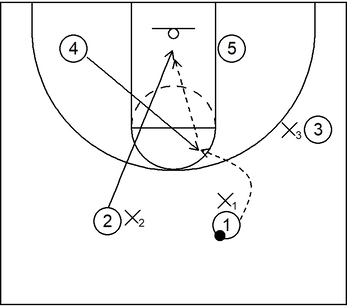
This is an example of standard blind pig action utilized within the triangle offense. Typically, 3 would receive the ball via the first pass by 1 to initiate the offense.
However, X3 is playing denial defense near the passing lane, which also means that X3 could potentially deflect or intercept the ball if 1 were to throw it in that direction.
So, as a result of the wing being denied, 2 would commonly receive the ball via the lag pass thrown by 1.
Unfortunately, 2 cannot easily receive the ball either because of the denial defense of X2 and since those options are denied, the next step is an automatic sequence by the weak side forward.
Therefore, 4 executes a flash cut near the right side high post area and receives the ball from 1.
Following that, 2 immediately executes a backdoor cut to the basket, receives the ball from 4, and scores at the rim with a layup or dunk to complete the blind pig action.
What are simple examples of blind pig variations
Wing Reverse – Part 1
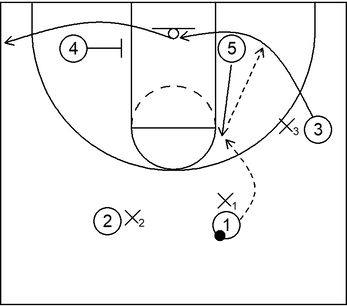
This is an example of wing reverse, a pressure release counter within the triangle offense.
This variation is slightly different from regular blind pig action because the strong side center flashes to the high post as opposed to the weak side forward.
To begin, 1 cannot pass the ball to either 2 or 3. When that happens, 5 executes a flash cut towards the right side high post elbow.
Immediately after that, 3 could backdoor cut to the basket, receive the ball from 5, preferably by way of a bounce pass, and score via a layup or dunk.
Also, if 3 is not open, then 3 could cut through to the left side corner by way of a brush screen set by 4 near the left side low post area.
Wing Reverse – Part 2
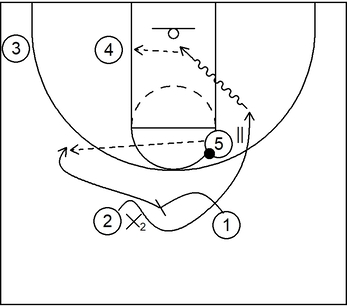
Continuing with the wing reverse action, 2 could cut towards 5 by way of an away screen set by 1.
Following that, 2 could then receive the ball via a handoff from 5 and attack the rim for a scoring opportunity.
In addition to that, 4 could also receive the ball from 2 as an alternative scoring option as well.
Wing Reverse Wrinkle
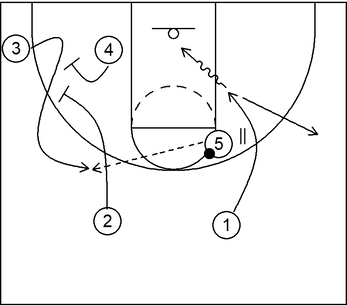
This is a wrinkle of the original wing reverse action after 3 executes the backdoor cut but does not receive the ball from the high post player.
To start, 1 cuts toward 5 to receive a handoff. From there, 1 drives to the basket and scores via a layup or dunk.
However, if 1 is not open to receive the handoff, then 1 could simply cut out towards the right side wing area.
Also, at the same time, 3 could cut towards the left side wing via the stagger screen set by 2 and 4.
Following that, 2 could receive the ball from 5 and take the three-point jump shot if open.
1-4 High – Example 1 – Part 1
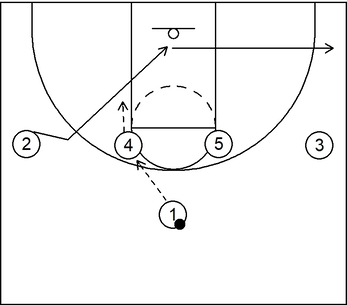
This is an example of a blind pig variation derived from the 1-4 high set. To start, 4 receives the ball from 1 and immediately afterwards, 2 backdoor cuts to the basket.
From there, 2 could receive the ball and score via a layup or dunk. However, if 2 is not open, then 2 could cut through to the right side corner.
1-4 High – Example 1 – Part 2
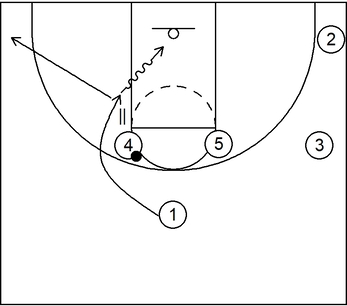
Next, 1 could cut towards 4 and receive the ball via a handoff. After that, 1 could drive to the basket and attempt to score by way of a layup or dunk.
Conversely, if 1 could not receive the handoff, then 1 could cut towards the left side corner.
1-4 High – Example 1 – Part 3
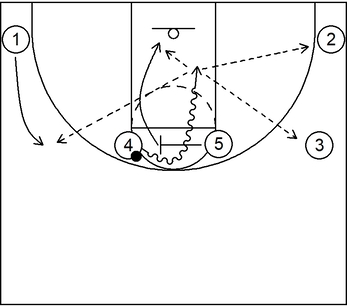
After 1 cuts through to the corner, 4 and 5 can execute elbow get action. That is to say, 4 could drive to the basket via the on-ball screen set by 5, who would also roll to the basket as well.
Furthermore, as that happens, 1 could execute the shake action by lifting up from the left side corner towards the left side wing.
Next, 4 could score at the rim or 5 could receive the ball from 4, especially if alley-oop action is available via a lob pass.
In addition to that, 1, 2, or 3 could also potentially receive the ball from 4, particularly via the kick pass, and then take jump shots if open.
1-4 High – Example 2 – Part 1

This is another example of a blind pig variation derived from the 1-4 high set. However, this time, 5 receives the ball from 1.
After that, 3 immediately backdoor cuts to the rim, receives the ball from 5, and quickly scores with a layup or dunk.
Nevertheless, if 3 is not able to receive the ball, then 3 could continue through to the left side corner.
1-4 High – Example 2 – Part 2

Next, 1 could cut to the basket via the back screen set by 4, receive the ball from 5, and score via a layup or dunk.
If 1 is not open, then 1 could continue through to the right side corner.
1-4 High – Example 2 – Part 3
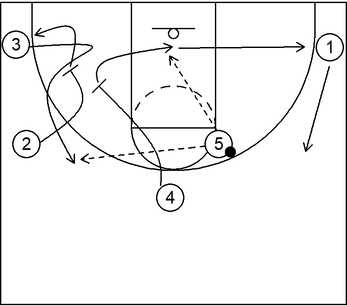
Afterwards, 3 could cut to the left side wing via the stagger screen set by 2 and 4.
Also, 4 could slip the screen towards the basket while 3 fills and replaces at the left side corner.
From there, 3 could receive the ball from 5 and score by way of a three-point jump shot if open.
Alternatively, 4 could receive the ball from 5 and score via a layup, dunk, or low post move such as a hook shot.
Additionally, if 3 or 4 are not open, then 4 could cut towards the right side corner while 1 lifts up toward the right side wing area.
1-4 High – Example 2 – Part 4
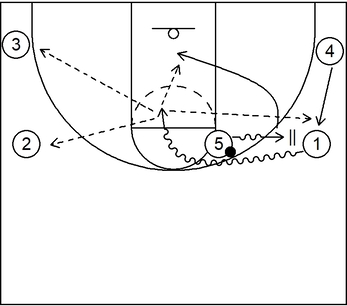
Next, 5 could execute a dribble handoff with 1. Immediately after that, 1 could attack the rim and try to get into the lane while 5 rolls to the basket.
Also, as that occurs, 4 could shake up towards the right side wing. From there, 1 could score with a mid-range jump shot, floater, or layup following dribble penetration if those options are available.
Moreover, 5 could also receive the ball from 1 and score at the rim as well. Alternatively, 2, 3, or 4 could receive the ball from 1 via the kick pass and score by way of open jump shots.